INTRODUCTION.
"The visceropericardial coelom (= VP coelom) is the largest coelom in decapodiform and vampyromorph cephalopods. In these taxa, this coelom encloses virtually all of the gonad, and much of the visceral nucleus among other structures; in the Octopoda, however, the VP coelom is greatly reduced. In all coleoids, eggs and sperm are released into the coelom and picked up by the gonoducts for passage to the exterior. The VP coelom also communicates with the nephridial coelom and the mantle cavity via a pair of ducts that open at the base of the nephridial papillae. The VP coelom also communicates with the lumen of each pericardial gland thus plays a role in transferring waste products to the mantle cavity. In addition to these and other functions the coelom facilitates the free, lubricated, independent movement of the viscera decapodiforms and Vampyroteuthis; in Octopoda, this latter function is presumably taken over by extensive blood sinuses.
OCTOPODIFORMES. VAMPYROMORPHA. Vampyroteuthis infernalis.

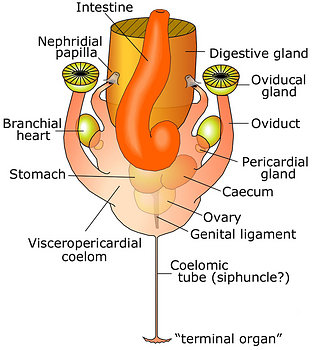
Figure. Vampyroteuthis, ventral view. The pink color indicates the extent of the VP coelom. The digestive gland as been drawn as slightly transparent so that the VP coelom posterodorsal to the gland can be seen. The crop which is dorsally located, however, cannot be seen. Drawing modified from Young and Vecchione, 1996.
The VP coelom of Vampyroteuthis is a large cavity with a thin epithelial lining that covers all or much of the ovary (which is suspended in the coelom), caecum, stomach, ventrical and a posterior portion of the digestive gland. Laterally, small outpocketings of the coelom engulf the pericardial gland and the tip of the branchial heart. This region is called the pericardial chamber of the VP coelom. The anterolateral corners of the VP coelom extend as thin ducts that terminate in pores at the bases of the nephridial papillae which, in turn, open into the mantle cavity. At its posterior end the VP coelom extends as a long, narrow tube (presumably homologous to the siphuncle of Spirula, sepiids, nautilids and numerous fossil cephalopods) to the apex of the conus of the gladius where it expands into a disc-shaped, flattened sac with peculiar tissue on its posterior surface to form a "terminal organ" of unknown function. Posterolaterally the coelom extends outward as the internal lining of the short, broad oviducts in the female or the vas deferens in the male.
OCTOPODIFORMES. CIRATTA. Stauroteuthis syrtensis and Cirroctopus glacialis:

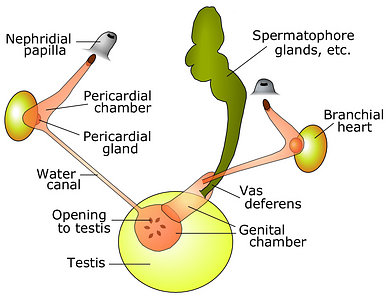
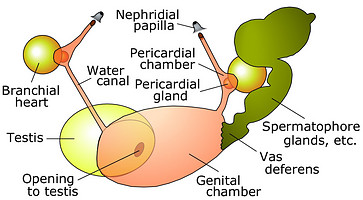
Figure. Ventral views. Left - Cirroctopus glacialis, male. Right - Stauroteuthis syrtensis, male. The pink color indicates the extent of the VP coelom. Drawing modified from Young and Vecchione, 1996.
The VP coelom in C. glacialis is very restricted and is represented by two small chambers (pericardial and genital chambers) and the ducts (water canals) that connect them. The genital chamber consists of two parts, a small region (the inner sac) that covers a small patch on the testis where a series of pores open into the testis and a slightly inflated region (the outer sac) that extends outward from this region. The two sacs are partially separated by a transverse membrane. The gonoduct and the left water canal open into the outer sac near its lateral extent. The right water canal, which is longer and more slender than its left counterpart, opens into the inner sac. Anteriorly each water canal opens into a pericardial chamber that surrounds a pericardial gland and a small region of the branchial heart, then tapers into a duct that opens into a nephridial coelom at the base of a nephridial papilla. In S. syrtensis the organization of the coelom is similar but there is no separation into inner and outer sacs of the genital chamber and this chamber is much larger than that of C. glacialis. There is a single pore that opens into the testis and the vas deferens is much broader where it opens into the genital chamber than in C. glacialis. In both drawings above, the thickness of the water canals is exaggerated for clarity.
A genital pocket (invagination from the mantle cavity) that surrounds much of the male spermatophore gland complex in coleoids is absent from cirrates.
OCTOPODIFORMES. INCIRRATA. Japetella diaphana:

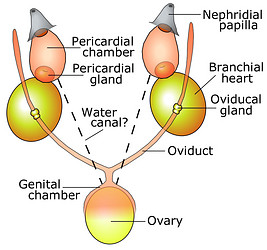
Figure. Japetella, ventral view. The pink color indicates the extent of the VP coelom. Drawing modified from Young and Vecchione, 1996.
Japetella diaphana (Amphitretidae) is a representative of the Suborder Incirrata. In this suborder, the visceropericardial coelom is greatly reduced, as in the Cirrata, and is represented by two small chambers (pericardial and genital chambers) and the canals (water canals) that connect them. In Japetella we were unable to locate the water canals, which are generally thought to be typical of the octopodidae at least (e.g., Isgrove, 1909), and they are represented by dashed lines in the drawing. Presumably the genital chamber covers the entire ovary but in our dissection of Japetella we could not separate the tissues cleanly to determine its full extent. The pericardial chambers open directly into the nephridial coeloms at the base of the nephridial papillae without forming slender ducts.In Japetella the genital chamber is more restricted than in the two incirrates. The oviducts join and connect by a short duct to the genital chamber. The water canals could not be located but could have been missed. Each pericardial chamber extends directly (no duct) to the base of the nephridial papilla.
DECAPODIFORMES. OEGOPSIDA. Sthenoteuthis oualaniensis.

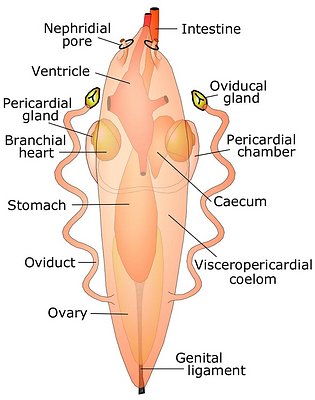
Figure. Sthenoteuthis, ventral view. The pink color indicates the extent of the VP coelom. Drawing modified from Young and Vecchione, 1996.
Stenoteuthis has an extensive VP coelom that is presumably representative of the Oegopsida. The coelom extends from the digestive gland to the conus of the gladius and incorporates most of the stomach, caecum ventricle, posterior esophagus and gonad. The pericardial chamber of the VP coelom forms a shelf on the ventral surface of the coelom that encloses much of both branchial hearts and pericardial glands. The chamber appears to be continuous across the ventral midline, as it is in Sepia (Thompsett, 1939), but we could not be certain. Anteriorly the VP coelom narrows abruptly into ducts which often extend through the nephridial pores to open into the mantle cavity. The nephridial pores do not reside on the ends of distinct papillae.


 Go to quick links
Go to quick search
Go to navigation for this section of the ToL site
Go to detailed links for the ToL site
Go to quick links
Go to quick search
Go to navigation for this section of the ToL site
Go to detailed links for the ToL site